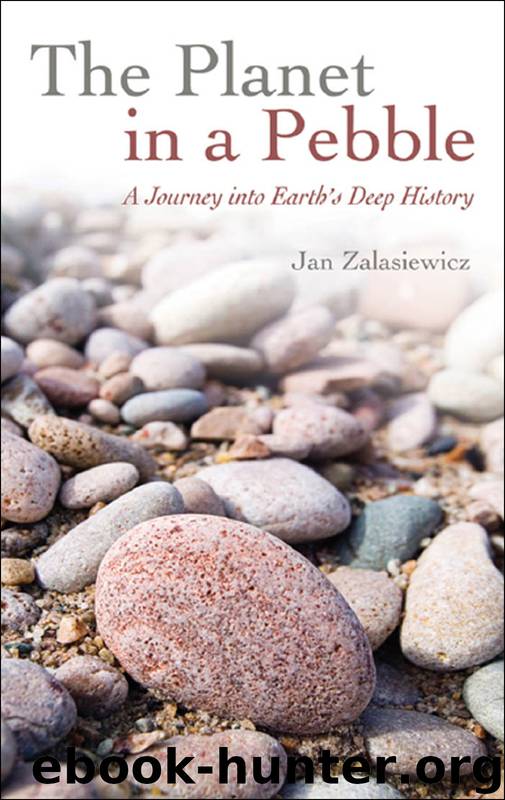The Planet in a Pebble by Zalasiewicz Jan;

Author:Zalasiewicz, Jan;
Language: eng
Format: epub
Publisher: Oxford University Press USA - OSO
Published: 2010-03-14T16:00:00+00:00
CHEMICAL MESSAGES
What, for instance, was the sum total of life, of living organisms, in the oceans that stretched out from that particular spot of the ancient Welsh sea floor, a few square centimetres across, that much later became the pebble? This is a huge, almost abstract question. Nevertheless, potential clues are there, even within the pebble material itself. Their meaning is still ambiguous, but the evidence is now technically easy to come by, so such evidence is currently being amassed and studied by scientists around the world, in the hope of illuminating another side of the Silurian world. It is science as the art of the possible, here at work, and it would here investigate the nature of the dark, carbon-rich component of the pebble.
Carbon comes in two main stable forms, a lighter isotope, 12C, with six neutrons and six protons in its nucleus, and a heavier isotope, 13C, with seven neutrons and six protons. These have the same chemical properties, but because of their difference in mass, are often segregated in chemical or biological reactions. Photosynthetic plankton, for instance, absorb both isotopes—but show a distinct partiality for 12C, and will preferentially absorb more of this light isotope in building their bodies—and consequently this will leave a little more of the heavier 13C in the environment around it.
Now, when the good times roll, large amounts of plankton will live and die. If they then fall to the sea floor and are buried in sea floor sediments, taking their excess of light carbon with them, the oceans above will be enriched in the heavy carbon isotope. Subsequent generations of plankton still segregate out the lighter isotope but, because there is less of that in the environment overall, these succeeding plankton will contain more heavy carbon than their predecessors. And so when these in turn fall to the sea floor and are buried, their particular stratum will have a greater proportion of light carbon atoms than the ocean water above—but a smaller proportion than in the underlying layer of sea floor mud.
It is a grand atomic reshuffling exercise that can take place on a truly global scale. If life thrives for a good long while, and is then buried, then the whole carbon isotope balance of the world can change. This kind of change can now be detected, routinely, by modern atom-counting machines. It just takes a few grams of carbon-bearing mudrock, so a small part of the pebble will suffice. That needs to be crushed, flash-heated and converted into a plasma; the ions in the plasma are then whirled around a curved track, within a magnetic field. The lighter ions are deflected less by that field than are the heavier ones, and so the different atomic weights separate out before the ions slam into carefully positioned detectors, that count the number of impacts of each type (that is, each weight category) of ion.
This unambiguously and precisely gives the ratio of light to heavy carbon in the pebble sample. Now as to what that means—that requires a little more thought.
Download
This site does not store any files on its server. We only index and link to content provided by other sites. Please contact the content providers to delete copyright contents if any and email us, we'll remove relevant links or contents immediately.
Man-made Catastrophes and Risk Information Concealment by Dmitry Chernov & Didier Sornette(4736)
The Revenge of Geography: What the Map Tells Us About Coming Conflicts and the Battle Against Fate by Kaplan Robert D(3597)
Zero Waste Home by Bea Johnson(3292)
COSMOS by Carl Sagan(2950)
In a Sunburned Country by Bill Bryson(2948)
Good by S. Walden(2915)
The Fate of Rome: Climate, Disease, and the End of an Empire (The Princeton History of the Ancient World) by Kyle Harper(2436)
Camino Island by John Grisham(2383)
A Wilder Time by William E. Glassley(2363)
Organic Mushroom Farming and Mycoremediation by Tradd Cotter(2307)
Human Dynamics Research in Smart and Connected Communities by Shih-Lung Shaw & Daniel Sui(2178)
The Ogre by Doug Scott(2114)
Energy Myths and Realities by Vaclav Smil(2060)
The Traveler's Gift by Andy Andrews(2012)
Inside the Middle East by Avi Melamed(1940)
Birds of New Guinea by Pratt Thane K.; Beehler Bruce M.; Anderton John C(1906)
Ultimate Navigation Manual by Lyle Brotherton(1768)
A History of Warfare by John Keegan(1715)
And the Band Played On by Randy Shilts(1615)
